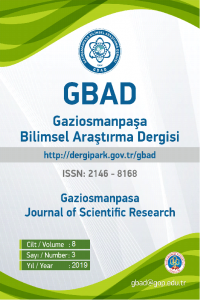Abstract
Üniversitelerin önemli
çıktılarından bir tanesi araştırmadır. Bilimsel araştırma etkinlikleri yoluyla
öğretim üyeleri ulusal ve uluslararası gelişime katkı sağlamaktadır. Bu nedenle,
akademisyenlerin araştırma üretkenliklerinin ölçülmesi önemli ve gerekli bir problem
olarak ele alınmaktadır. Bu problemin çözülmesi için birçok model geliştirilmiştir.
Bu makalede, yapısal ve yapısal olmayan çok sayıda kriterin bulunduğu akademik üretkenlik
değerlemesi için çok kriterli karar verme metotlarından Bulanık TOPSIS tabanlı bir
karar modeli önerilmiştir. Bu çalışmada, öncelikle Akademik Teşvik Ödeme Yönetmeliğinde yer alan faaliyetleri temel alarak hazırlanan kriterlerin önem dereceleri ve
sıralamaları tespit edilecektir. Bulunan önem dereceleri kriter ağırlıkları olarak
kullanılarak bir akademik kadroya başvuran adaylar arasından en uygun öğretim
üyesinin seçilmesi için bulanık TOPSIS metodu tabanlı bir yöntem geliştirilecektir.
References
- Abramo G., D’Angelo C., 2014. How do you define and measure research productivity? Scientometrics 101(2) :1129–1144.
- Bellman, R.E. and Zadeh, L.A. (1970) Decision-Making in a Fuzzy Environment. Management Sciences, 17, B141B164.
- Brew A., Boud D., Namgung S.U., Lucas L., Crawford K.,2016. Research productivity and academics’ conceptions of research. High Educ (2016) 71: 681. Springer Netherlands.
- Chen, C.T., 2000. Extensions of the TOPSIS for Group Decision-Making Under Fuzzy Environment, Fuzzy Sets and Systems, Cilt 114, 1-9.
- Chen, C. T., Lin, C. T. ve Huang, S. F., 2005. A Fuzzy Approach for Supplier Evaluation and Selection in Supply Chain Management, International Journal of Production Economies, 1-13.
- Evren, R. ve Ülengin, F.,1992. Yönetimde Çok Amaçlı Karar Verme, İ.T.Ü. Matbaası, İstanbul.
- Gonzalez-Brambila C. ve Veloso F., 2007. The Determinants of Research Productivity: A Study of Mexican Researchers, Research Policy, 36, 7, 1035-1051.
- Hwang, C.L. ve Yoon, K., 1981. Multiple Attribute Decision Making: Methods and Applications, Springer-Verlag, Berlin/Hiedelberg.
- Mengi F., Schreglmann S.,2013. Akademisyenlik Bağlamında Bilimsel Üretkenliği Etkileyen Çevresel Faktörler, Amasya Üniversitesi Eğitim Fakültesi Dergisi 2(1), 1-17.
- Ölçer A.İ. ve Odabaşı, A. Y.,2005. A New Fuzzy Multiple Attributive Group Decision Making Methodology and its Application to Population/Maneuvering System Selection Problem, European Journal of Operational Research, 166(1), 93–114.
- Tzeng, G.H., 2005. Fuzzy MCDM in Past, Present, and Future, Taiwanese Association for Artificial Intelligence Conference.
- Uzoka, F.M.E., 2008. A fuzzy-enhanced multicriteria decision analysis model for evaluating university Academics’ research output, Information Knowledge Systems Management 7273–299 IOS Press.
- Zadeh, L.A., 1965. Fuzzy sets. Information and Control, 8 (3), pp. 338-353
Abstract
One of the foremost outputs of the universities is research. Through scientific research
the faculty of the universities contribute to the national and international development.
For this reason, measuring the research productivity of academics should be taken
as an important and necessary problem to be dealt with. In order to solve this problem
a lot of model is proposed. In this paper, among the multi criteria decision making
tools fuzzy TOPSIS method based decision tool is proposed for the academic research
productivity evaluation problem which is composed of many structured and unstructured
criteria. In this study, criteria formed using Academic Incentive Allowance Regulation
are sorted and their importance levels are calculated. Using the importance levels
as criteria weights, a fuzzy TOPSIS method based decision tool is developed for
selecting the most appropriate candidate among the applicants for an academic position.
Keywords
Personnel selection multi criteria decision making research productivity fuzzy TOPSIS method
References
- Abramo G., D’Angelo C., 2014. How do you define and measure research productivity? Scientometrics 101(2) :1129–1144.
- Bellman, R.E. and Zadeh, L.A. (1970) Decision-Making in a Fuzzy Environment. Management Sciences, 17, B141B164.
- Brew A., Boud D., Namgung S.U., Lucas L., Crawford K.,2016. Research productivity and academics’ conceptions of research. High Educ (2016) 71: 681. Springer Netherlands.
- Chen, C.T., 2000. Extensions of the TOPSIS for Group Decision-Making Under Fuzzy Environment, Fuzzy Sets and Systems, Cilt 114, 1-9.
- Chen, C. T., Lin, C. T. ve Huang, S. F., 2005. A Fuzzy Approach for Supplier Evaluation and Selection in Supply Chain Management, International Journal of Production Economies, 1-13.
- Evren, R. ve Ülengin, F.,1992. Yönetimde Çok Amaçlı Karar Verme, İ.T.Ü. Matbaası, İstanbul.
- Gonzalez-Brambila C. ve Veloso F., 2007. The Determinants of Research Productivity: A Study of Mexican Researchers, Research Policy, 36, 7, 1035-1051.
- Hwang, C.L. ve Yoon, K., 1981. Multiple Attribute Decision Making: Methods and Applications, Springer-Verlag, Berlin/Hiedelberg.
- Mengi F., Schreglmann S.,2013. Akademisyenlik Bağlamında Bilimsel Üretkenliği Etkileyen Çevresel Faktörler, Amasya Üniversitesi Eğitim Fakültesi Dergisi 2(1), 1-17.
- Ölçer A.İ. ve Odabaşı, A. Y.,2005. A New Fuzzy Multiple Attributive Group Decision Making Methodology and its Application to Population/Maneuvering System Selection Problem, European Journal of Operational Research, 166(1), 93–114.
- Tzeng, G.H., 2005. Fuzzy MCDM in Past, Present, and Future, Taiwanese Association for Artificial Intelligence Conference.
- Uzoka, F.M.E., 2008. A fuzzy-enhanced multicriteria decision analysis model for evaluating university Academics’ research output, Information Knowledge Systems Management 7273–299 IOS Press.
- Zadeh, L.A., 1965. Fuzzy sets. Information and Control, 8 (3), pp. 338-353
Details
| Primary Language | Turkish |
|---|---|
| Subjects | Engineering |
| Journal Section | Araştırma Makaleleri |
| Authors | |
| Publication Date | December 31, 2019 |
| Published in Issue | Year 2019 Volume: 8 Issue: 3 |


